-
Posts
578 -
Joined
-
Last visited
Content Type
Profiles
Forums
Store
Help Articles
Posts posted by Keith_W
-
-
Nice effort there, Ian
 One thing about SV heirloom carrots ... I never SV them together. The purple ones tend to discolour the yellow and orange ones, so I tend to SV them separately. I see that yours came out with the colours preserved.
One thing about SV heirloom carrots ... I never SV them together. The purple ones tend to discolour the yellow and orange ones, so I tend to SV them separately. I see that yours came out with the colours preserved. Oh yes ... when I SV them separately, it gives me an opportunity to introduce new flavours into the carrots
 I SV the orange carrots with cumin, the yellow carrots with ginger, and the purple carrots with cinnamon.
I SV the orange carrots with cumin, the yellow carrots with ginger, and the purple carrots with cinnamon. -
Well since we are posting pics of our Yee Sang I thought I would show off the one I made for last year's Chinese New Year (well technically it's still this year). It was (is) the Year of the Dragon, so I carved a dragon's head from a carrot:
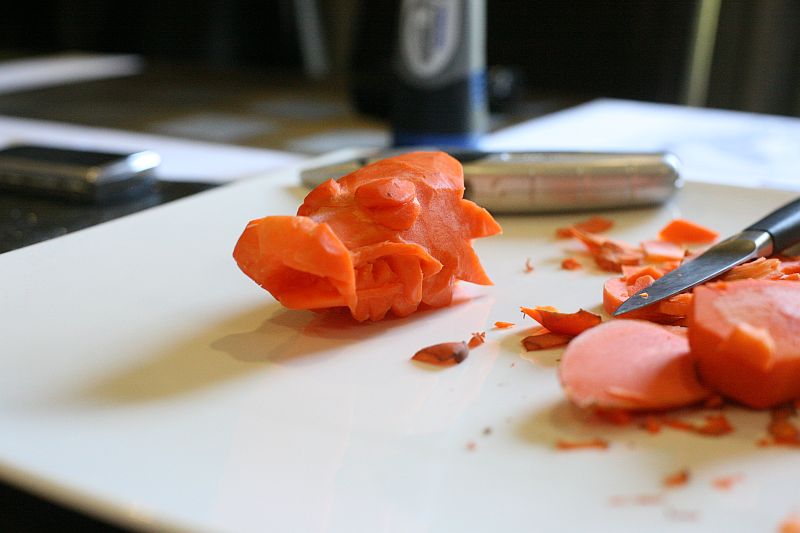
... then arranged the fish and peeled mandarin to look like a dragon:
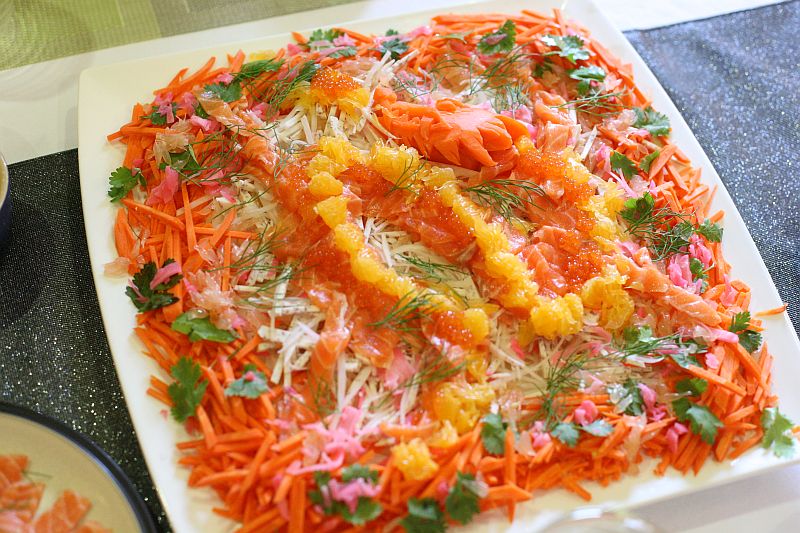
Yes I know it is missing the green radish, but unfortunately you can't find it in Australia at this time of the year

-
Thanks for the recipe Ranz. Chris, I can definitely use my Kamado. It goes up to 400C, enough to cremate the chicken in short order

-
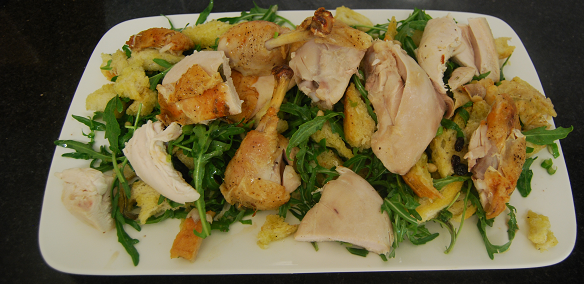
The Zuni Cafe roast chicken with bread salad. I was surprised the meat turned out as juicy as it did, given the very high roasting temperature and the fact I didn't manage to take it from the oven until it as a good 5C above what I'd take it to if I was cooking it sous vide.
That looks awesome! I have never heard of this, had to Google it. Fortunately, the web abounds with recipes for this. Something I have to make.
-
Like all garbage beef base, it contains cheap flavor boosters...."Natural beef flavor contains hydrolyzed wheat and hydrolyzed milk."
Aw, come on now. I know a guy who used to be a food scientist in McDonald's. I may not go there to eat myself, but I have nothing but admiration for him and the work that he did. Think about the challenge involved in making sure that your products meet the same standards everywhere in the world, when the food is prepared by 17 year olds who have never cooked in their life. Think of the logistics, and all the different suppliers, and how you would get them to meet your standards.
People on eG go gaga about Transglutaminase, LN2, sous-vide, and other innovations that are considered old hat by those veteran food scientists who work in places like McDonalds. Is it the snob factor that makes techniques only respectable when they migrate from the industrial to the artisan kitchen? Because nothing diminishes the fact that these amazing innovations would not have taken place without companies like McDonalds to drive them.
As for how wheat and milk derivatives can be turned into beef flavour - they are all amino acids and sugars. All you need to do is know how to rearrange them to get the flavour profile you want.
-
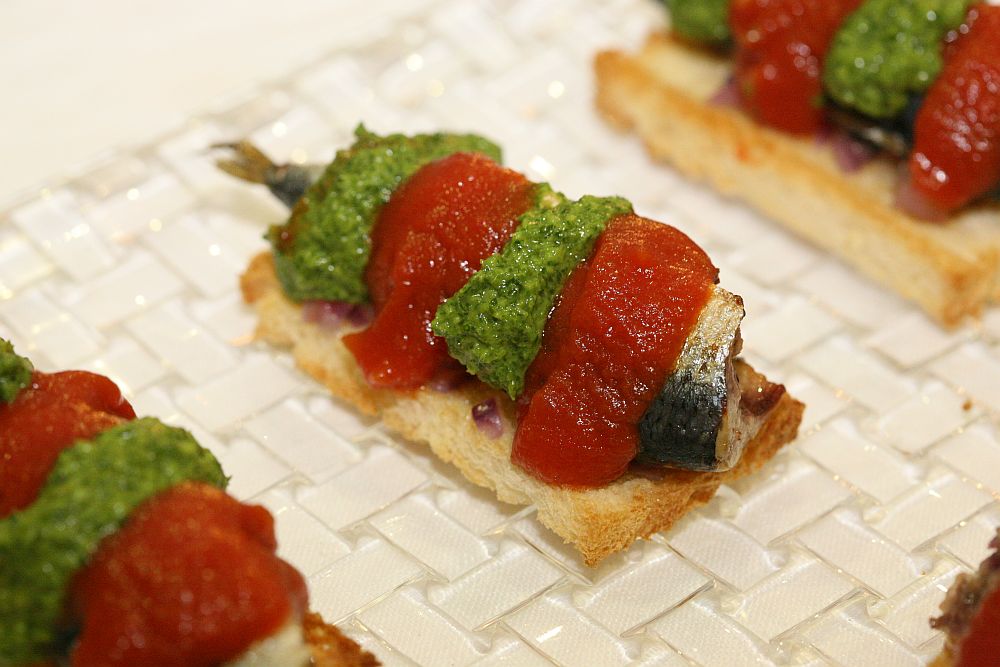
Sardines on toast. The sardines were stuffed with chopped capers and red onion. The green sauce is a salsa verde, the red sauce is a simple passata.
-
USA = 110V
Australia = 240V
Won't work unless you are happy to have a step-down transformer in your kitchen.
-
An immersion blender is NOT a substitute for a benchtop blender. Immersion blenders can make purees, but if you want the finest textured purees possible, you want a benchtop blender. You can still see particles when something is pureed with an immersion blender. Also - immersion blenders can not make smoothies, milkshakes (can't crush ice), nor can it crush iPhones or anything else in those "Will it blend?" videos

Having said that, nothing beats a stick blender for convenience, provided you are not too concerned about particle size. I use mine (a Bamix Swissline) VERY often, nearly every time I am cooking I will pull it out for something. It sure beats transferring whatever hot liquid I am working with to my food processor and then having to deal with spillage, wastage, and cleaning the bowl afterwards.
Before I owned my Bamix, I owned a Sunbeam stick blender for 10 years before it died. The Bamix is noticably smoother and quieter, although you wouldn't describe it as silent. Cleanup on the Bamix is dead easy - once I yank off the attachment, there are no annoying little nooks and crannies where food can get stuck.
I don't know about that Cuisinart, but there are plenty of people with 20 year old Bamix stick blenders around. I'm not sure there are very many people with 20 year old Cuisinarts. When you keep something for that long, the price difference is irrelevant.
-
 1
1
-
-
These are vegetables cut up ready to be roasted.
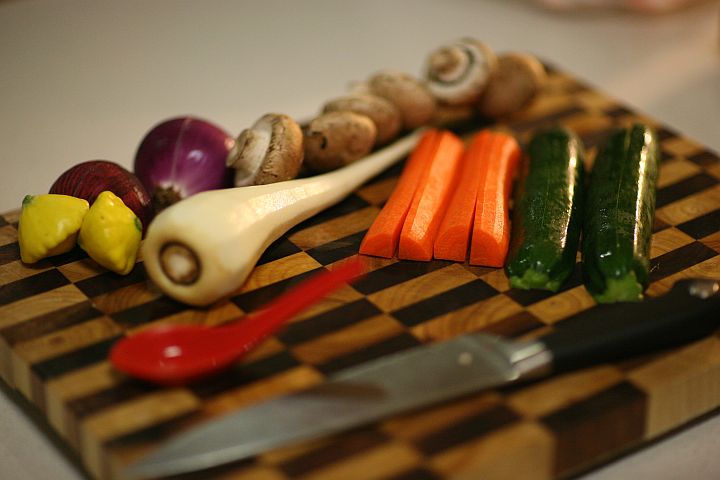
This is me playing with my rotisserie attachment in my oven.
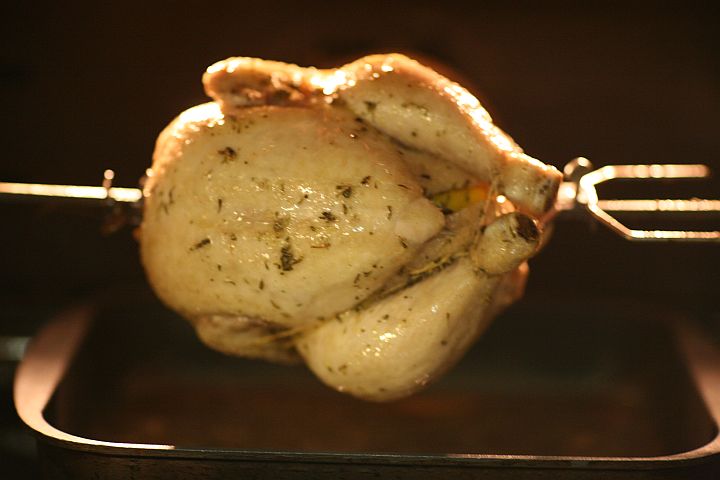
Simple mid week dinner - roast chicken with roast vegetables.
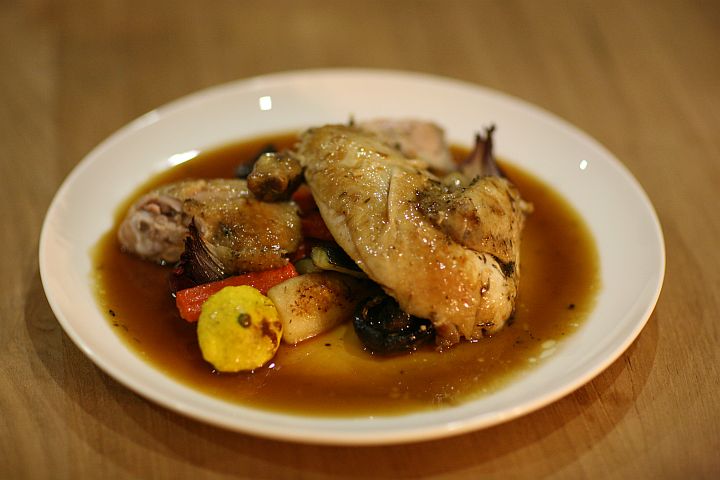
-
How does the cooking of red and black differ from the long grain whites or even brown?
Both types of rice are used in Chinese cooking.
Red rice actually comes in several varieties, some are glutinous, some are not. Some are more polished than others. I'm sorry I don't know the names, but the most common variety of red rice found here is the less polished glutinous variety. This means that the fibrous layer is still attached to the grain of rice, which itself will turn to goop when cooked. I am not aware of anybody cooking this like "normal" rice, although I am sure it possible. Its most common use is to make a kind of Chinese "sweet porridge", usually mixed in with some red bean and dried mandarin peel, and eaten as a dessert.
The black rice I have found also comes in two varieties. One is "wild black rice", the other is a polished black rice. Polished black rice is slightly glutinous and turns purple when cooked. As for "wild black rice", I bought some because I thought it was unusual. Bad mistake - this rice took forever to cook, and even then the husk was extremely chewy. I will confess right now that I have no idea how to cook wild black rice. I have some left, perhaps I will put it in the pressure cooker.
With any unfamiliar rice, it is best to err on adding too little water and undercooking, rather than too much water and overcooking. You can always add water and steam it some more. If you have added too much water and the rice has broken down, you will not be able to save it.
-
But still, using a sealed bag would not be a good idea, as it would easily explode with the water vapour produced inside the bag. The jars are never tightly closed inside the PC for that reason.
Hmm, I would have thought that the problem with using a sealed jar in a pressure cooker is that it would implode, rather than explode. For a plastic bag to explode in a pressure cooker, the contents of the bag has to reach a higher pressure than the surrounding atmosphere. I can't see that happening, unless the PC is suddenly vented.
-
David, the consomme was beefed up with some beef stock
 So there was some meatiness in there, as well as the usual veggies and bouquet garni. The beets contributed the colour. You don't need a lot of beetroot to make the thing dramatically red. And no, it wasn't too sweet.
So there was some meatiness in there, as well as the usual veggies and bouquet garni. The beets contributed the colour. You don't need a lot of beetroot to make the thing dramatically red. And no, it wasn't too sweet. -
Mine would have to be the beetroot consomme I made for Valentine's day. I used a traditional borscht recipe, but then removed all the vegetables after cooking, then filtered and clarified it. I made up more vegetables, all cut into heart shapes. Some were lightly steamed, some were left raw. The result was a beautiful light, clear, red, and refreshing broth with the crunch of fresh vegetables. I am even more proud because I came up with it myself

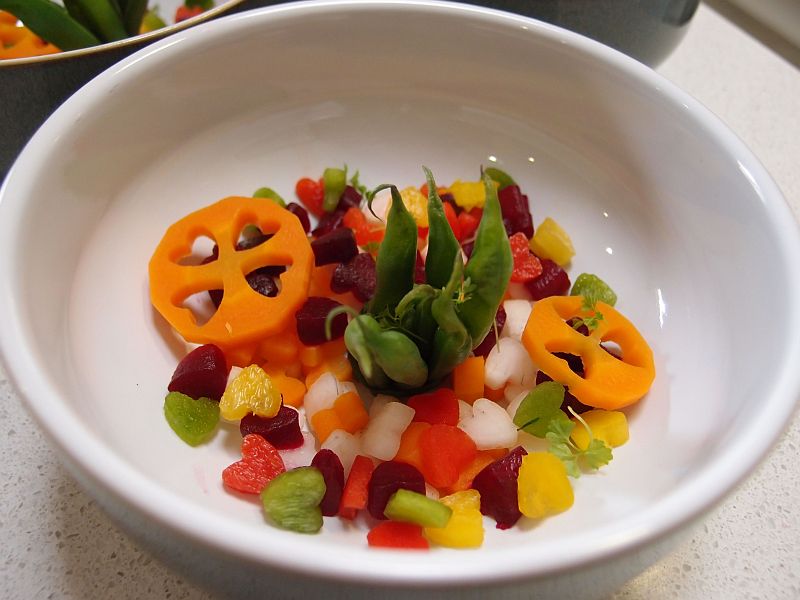

-
Interesting method, Kerry. I'm not so sure about soaking the rice for 8 hours though, and I am surprised that you obtained whole grains after soaking rice for that long. I have found from experience that even soaking rice for half an hour negatively affects the texture. I would soak rice grains if I am making congee, though.
-
The surface of the pan might seem smooth, but on a microscopic level it is full of jagged peaks and valleys. When metal heats up, heat travels through the metal crystals causing them to expand and shrink relative to each other. If you place something cold on the metal, it immediately cools the surface, causing the metal crystals to shrink and "grab" on to the food. When the pan gets hot again, the metal crystal expands and "releases" the food - this is why a piece of fish immediately sticks to the pan, but gets released after a certain period of time.
To get around the problem, there are several strategies. A layer of oil helps somewhat, but does not completely alleviate the problem. By far the best way (IMHO) is the Chinese solution of stir fry - the pan is superheated, such that any water that contacts the pan immediately evaporates causing the food to float on a bed of steam. The cook keeps the food moving around the pan, preventing areas of the pan from cooling and "grabbing" onto the food. Also, a seasoned wok has clumps of grease between the metal crystals, stopping them from grabbing onto pieces of food.
-
Yes that's right. In reality you CAN slow roast at 170F (75C) ... your meat will just be done sooner. As long as you monitor what's going on you should be fine.
-
- Fuchsia Dunlop - At various points in various recipes: Splash the wok with Shaoxing wine. What does this achieve, exactly? It's not deglazing as in Western recipes. Perhaps the wine doesn't serve the same function in various dishes - it's simply a flavoring element like soy sauce?
Helps to evaporate the alcohol, perhaps?
-
Yes, get an oven thermometer. Prop the door of your oven open. Adjust the heat of your oven until the oven thermometer gives the desired reading. Note that there may still be hot and cold spots in your oven.
-
Somehow I doubt places like Yook Woo Hin of that time derived their inspiration from this place called "Jimmy's Kitchen". (What was this "Jimmy's Kitchen"?)
I regret to inform you that the famous Yook Woo Hin restaurant has closed down. I grew up in KL. When I migrated from Malaysia, my farewell party was in that restaurant.
-
Thank you for the quick reply! I will consider what you advise for next time.
Overall is cooking confit sousvide supose to be very tender as well if done corectly?
I make SV confit duck all the time (admittedly not from the MC@H recipe) and the method you describe sounds very strange. SV for 24 hours with that much salt in the bag? Surely they mean to ask you to leave the legs in salt for a few hours, then wash it off and confit for 24 hours?
If done correctly, SV confit is a great alternative to the normal method. Much less wastage of duck fat, cleaner, and more convenient. And it tastes no different - dare I say better.
-
Risotto should be made with Vialone Nano rice! I have tried Carnaroli and Arborio - I find Vialone Nano the easiest to use. I make mine in the oven (no need to stir), and then give it a furious whisk before serving. This releases the starch and makes the rice creamy:
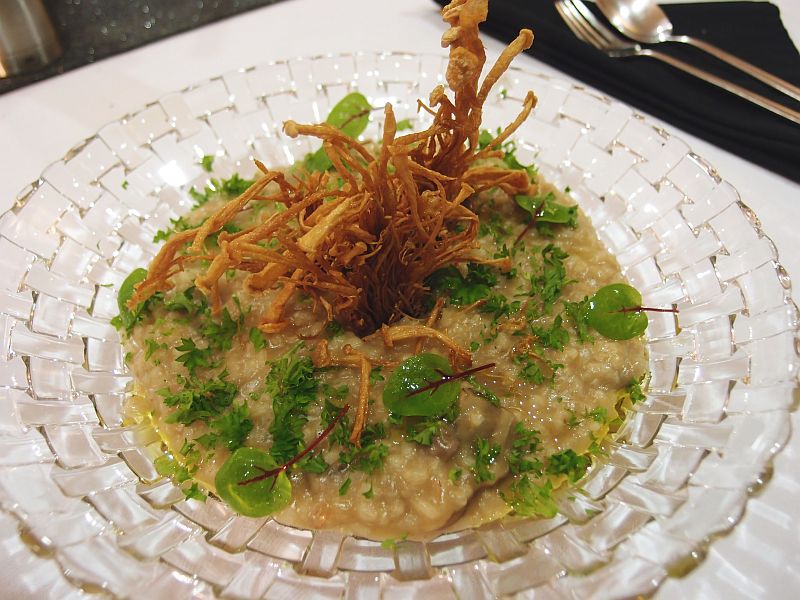
-
Hassouni, as MC says - you can make a risotto with any type of rice. You can even make risottos with non-rice, e.g. quinoa, cauliflower florets, finely diced carrot ... but IMO that is pushing the definition of "risotto" a little too far.
As for me, take a look at the avatar and guess my type of rice! I use Thai Jasmine rice, well rinsed, steamed, and fluffed.
-
I strongly advise against this. The longer rice is cooked, the more starch is released. If you heat congee for too long, you will be eating a bowl of pure starch with no visible rice grains left.
I have been eating congee since I was born, and making congee since I learnt to cook. My typical congee recipe is 10 parts water (and maybe some chicken or pork bone stock) to 1 part rice, simmered until the texture is just right. If I have leftover congee and try to reheat it, water must be added otherwise it is too thick.
(edit) having said that, congee is made differently in different parts of China. Some congees are more akin to a light broth with whole rice grains floating in it. I am Cantonese - our congee is more typical of what you would find in most restaurants in the West - i.e. the congee is opaque, with some thickening from the starch, and a contrast in texture from softened rice grains.
-
Beautiful as always, scottyboy!
Basquecook if you are in Spain, I would love to see you do an eG food blog some time!



Chinese Eats at Home (Part 3)
in China: Cooking & Baking
Posted
Braised abalone with lettuce.
I got a little bit fed up of my Hong Kong friend constantly needling me that my food is not Chinese food, it is Western. Well I suppose that it is Western tinged Cantonese food, a bit like my awful Cantonese accent where I sound like the White villain in Cantonese movies. I speak recognizable Cantonese, it just sounds as if a Westerner was speaking it.A bit like my food I suppose - it is recognizably Chinese, it just seems as if it was prepared by a Westerner
To really irritate him, I served this abalone (which was braised in the traditional Chinese style) in a Western style plating and told him it was Ormeaux Braises avec de mille-feuille la Laitue.